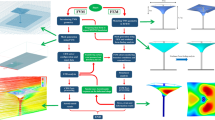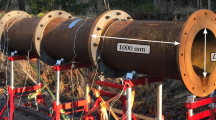Abstract
The paper addresses modelling concepts based on the RANS equations for laminar-turbulent transition prediction in general-purpose CFD codes. Available models are reviewed, with emphasis on their compatibility with modern CFD methods. Requirements for engineering transition models suitable for industrial CFD codes are specified. A new concept for transition modeling is introduced. It is based on the combination of experimental correlations with locally formulated transport equations. The concept is termed LCTM – Local Correlation-based Transition Model. An LCTM model, which satisfies most of the specified requirements is described, including results for a variety of different complex applications. An incremental approach was used to validate the model, first on 2D flat plates and airfoils and then on to progressively more complicated test cases such as a three-element flap, a 3D transonic wing and a full helicopter configuration. In all cases good agreement with the available experimental data was observed. The authors believe that the current formulation is a significant step forward in engineering transition modeling, as it allows the combination of transition correlations with general purpose CFD codes. There is a strong potential that the model will allow the 1st order effects of transition to be included in everyday industrial CFD simulations.
Similar content being viewed by others
References
Abu-Ghannam, B.J., Shaw, R.: Natural transition of boundary layers — the effects of turbulence, pressure gradient and flow history. J. Mech. Eng. Sci. 22, 213–228 (1980)
Arts, T., Lambert de Rouvroit, M., Rutherford, A.W.: Aero-thermal Investigation of a Highly Loaded Transonic Linear Turbine Guide Vane Cascade. von Karman Institute for Fluid Dynamics, Technical Note 174 (1990)
Jones, W.P., Launder, B.E.: The calculation of low Reynolds number phenomena with a two-equation model of turbulence. Int. J. Heat Mass Transfer 15, 301–314 (1973)
Klausmeyer, S.M., Lin, J.C.: Comparative Results From a CFD Challenge Over a 2D Three-element High-Lift Airfoil. NASA Technical Memorandum 112858 (1997)
Langtry, R.B., Gola, J., Menter, F.R.: Predicting 2D Airfoil and 3D Wind Turbine Rotor Performance using a Transition Model for General CFD Codes, AIAA Paper 2006-0395, 44th AIAA Aerospace Sciences Meeting and Exhibit, Reno NV (2006)
Langtry, R.B., Menter, F.R., Likki, S.R., Suzen, Y.B., Huang, P.G., Völker, S.: A Correlation based Transition Model using Local Variables Part 2 — Test Cases and Industrial Applications. ASME-GT2004-53454, ASME TURBO EXPO 2004, Vienna, Austria (2004)
Langtry, R.B., Menter, F.R.: Transition Modeling for General CFD Applications in Aeronautics, AIAA Paper 2005-522, Reno, Nevada (2005)
Langtry, R.B., Sjolander, S.A.: Prediction of Transition for Attached and Separated Shear Layers in Turbomachinery. In: AIAA-2002-3643, 38th AIAA/ASME/SAE/ASEE Joint Propulsion Conference and Exhibit (2002)
Lardeau, S., Leschziner, M.A., Li, N.: Modelling bypass transition with low-Reynolds-number nonlinear Eddy-viscosity closure. Flow Turbul. Combust. 73, 49–76 (2004)
Mayle, R.E.: The role of laminar-turbulent transition in gas turbine engines. J. Turbomach. 113, 509–537 (1991)
Mayle, R.E., Schulz, A.: The path to predicting bypass transition. ASME J. Turbomach. 119, 405–411 (1997)
Mayle, R.E.: Transition in a separation bubble. J. Turbomach. 118, 752–759 (1996)
McIlroy, H.M., Budwig, R.S.: The boundary layer over turbine blade models with realistic rough surfaces. ASME-GT2005-68342, ASME TURBO EXPO 2005, Reno-Tahoe, Nevada, USA (2005)
Menter, F.R.: Two-equation Eddy-viscosity turbulence models for engineering applications. AIAA J. 32(8), 1598–1605 (1994)
Menter, F.R., Esch, T., Kubacki, S.: Transition modelling based on local variables. In: 5th International Symposium on Turbulence Modeling and Measurements, Mallorca, Spain (2002)
Menter, F.R., Langtry, R.B., Likki, S.R., Suzen, Y.B., Huang, P.G., Völker, S.: A correlation based transition model using local variables part 1 — model formulation. In: ASME-GT2004-53452, ASME TURBO EXPO 2004, Vienna, Austria (2004)
Michelassi, V., Wissink, J.G., Rodi, W.: Analysis of DNS and LES of flow in a low pressure turbine cascade with incoming wakes and comparison with experiments. Flow Turbul. Combust. 69, 295–330 (2002)
Morkovin, M.V.: On the many faces of transition. In: Wells, C.S. (ed.) Viscous Drag Reduction, pp 1–31. Plenum, New York (1969)
Rodi, W., Scheuerer, G.: Calculation of laminar-turbulent boundary layer transition on turbine blades. In: AGARD CP 390 on Heat transfer and Cooling in Gas Turbines, 18-1 (1984)
Savill, A.M.: Some recent progress in the turbulence modelling of by-pass transition. In: So, R.M.C., Speziale, C.G., Launder, B.E. (eds.) Near-Wall Turbulent Flows. Elsevier, The Netherlands, p. 829 (1993)
Savill, A.M.: One-point closures applied to transition. In: Hallbäck, M., et al. (eds.) Turbulence and Transition Modelling, pp. 233–268. Kluwer, Dordrecht (1996)
Savill, A.M.: By-Pass Transition using Conventional Closures. In: Launder, B.E., Sandham, N.D. (eds.) Closure Strategies for Turbulent and Transitional Flows, Ch. 17, pp. 464–492. Cambridge University Press, Cambridge (2002)
Savill, A.M.: New strategies in modelling by-pass transition. In: Launder, B.E., Sandham, N.D. (eds.) Closure Strategies for Turbulent and Transitional Flows, Ch. 18, pp. 492–521. Cambridge University Press, Cambridge (2002)
Schubauer, G.B., Klebanoff, P.S.: Contribution on the Mechanics of Boundary Layer Transition. NACA TN 3489 (1955)
Schulz, H.D., Gallus, H.D.: Experimental investigation of the three-dimensional flow in an annular compressor cascade. ASME J. Turbomach. 110, (October 1988)
Simms, D., Schreck, S., Hand, M, Fingersh, L.J.: NREL Unsteady Aerodynamics Experiment in the NASA-Ames Wind Tunnel: A Comparison of Predictions to Measurements. NREL Technical report, NREL/TP-500-29494 (2001)
Smith, A.M.O., Gamberoni, N.: Transition, Pressure Gradient and Stability Theory. Douglas Aircraft Company, Long Beach, California Rep. ES 26388 (1956)
Sobieczky, H.: DLR – F5: Test Wing for CFD and Applied Aerodynamics, Test Case B-5 in AGARD FDP Advisory Report AR 303: Test Cases for CFD Validation (1994)
Steelant, J., Dick, E.: Modeling of bypass transition with conditioned Navier-Stokes equations coupled to an intermittency transport equation. Int. J. Num. Methods Fluids 23, 193–220 (1996)
Steelant, J., Dick, E.: Modeling of laminar-turbulent transition for high freestream turbulence. J. Fluids Eng. 123, 22–30 (2001)
Stock, H.W., Haase, W.: Navier–Stokes airfoil computations with eN transition prediction including transitional flow regions. AIAA J. 38(11), 2059–2066 (2000)
Suzen, Y.B., Huang, P.G.: Modeling of flow transition using an intermittency transport equation. J. Fluids Eng. 122, 273–284 (2000)
Suzen, Y.B., Xiong, G., Huang, P.G.: Predictions of transitional flows in low-pressure turbines using an intermittency transport equation. AIAA J. 40, 254–266 (2002)
Suzen, Y.B., Huang, P.G., Hultgren, L.S., Ashpis, D.E.: Predictions of separated and transitional boundary layers under low-pressure turbine airfoil conditions using an intermittency transport equation. J. Turbomach. 125(3), 455–464 (July 2003)
Van Driest, E.R., Blumer, C.B.: Boundary layer transition: Freestream turbulence and pressure gradient effects. AIAA J. 1(6), 1303–1306 (1963)
Van Ingen, J.L.: A suggested semi-empirical method for the calculation of the boundary layer transition region. Univ. of Delft, Dept. Aerospace Engineering, Delft, The Netherlands, Rep. VTH-74 (1956)
Walters, D.K., Leylek, J.H.: A new model for boundary-layer transition using a single-point Rans approach. J. Turbomach. 126, 193–202 (2004)
Wilcox, D.C.W.: Simulation of transition with a two-equation turbulence model. AIAA J. 32(2) (1994)
Wu, X., Jacobs, R., Hunt, J., Durbin, P.: Simulation of boundary layer transition induced by periodically passing wakes. J. Fluid Mech. 398, 109–153 (1999)
Zierke, W.C., Deutsch, S.: The Measurement of Boundary Layers on a Compressor Blade in Cascade – Vols. 1 and 2. NASA CR 185118 (1989)
Author information
Authors and Affiliations
Corresponding author
Rights and permissions
About this article
Cite this article
Menter, F.R., Langtry, R. & Völker, S. Transition Modelling for General Purpose CFD Codes. Flow Turbulence Combust 77, 277–303 (2006). https://doi.org/10.1007/s10494-006-9047-1
Accepted:
Published:
Issue Date:
DOI: https://doi.org/10.1007/s10494-006-9047-1




